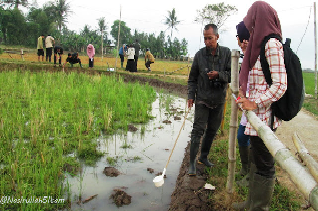Survey of Malaria Vectors in the Rainy Season in Inalipue Village, Wajo District, South Sulawesi
Abstract
Climate change will affect the physical and biological environment that supports the development of various infectious diseases, including malaria. Wajo District, particularly Inalipue Village in Tanasitolo Sub-district, faces a major challenge in controlling the malaria vector, the Anopheles mosquito. The main objective of this survey was to identify and understand the environmental factors that contribute to Anopheles mosquito population density in Inalipue Village. Data were obtained by capturing adult mosquitoes using the Human Landing Collection (HLC) method as well as surveying Anopheles mosquito larval breeding sites. Mosquito trapping was conducted inside and outside the house and around livestock pens. Anopheles barbirostris was the most dominant species, found in all capture methods with the highest Man Biting Rate (MBR) of 1.00 for outdoor capture. Anopheles nigerrimus and Anopheles vagus were also found, although in smaller numbers. Of the 17 breeding habitat sites, 5 showed positive larval results. Water temperature, pH, and the presence of flora and fauna in these habitats varied, but most had ideal conditions for mosquito breeding. Anopheles barbirostris shows high adaptation to a wide range of habitats, making it the main vector. These findings provide a strong basis for local governments and health agencies to plan and implement more effective and integrated malaria control programs.
References
Agache, I., Sampath, V., Aguilera, J., Akdis, C. A., Akdis, M., Barry, M., & Nadeau, K. C. (2022). Climate change and global health: a call to more research and more action. Allergy, 77(5), 1389-1407.
Agyekum, T. P., Botwe, P. K., Arko-Mensah, J., Issah, I., Acquah, A. A., Hogarh, J. N., & Fobil, J. N. (2021). A systematic review of the effects of temperature on Anopheles mosquito development and survival: implications for malaria control in a future warmer climate. International journal of environmental research and public health, 18(14), 7255.
Babba, I. (2007). Faktor - Faktor Risiko Yang Mempengaruhi Kejadian Malaria (Studi Kasus Di Wilayah Kerja Puskesmas Hamadi Kota Jayapura). In Program Pascasarjana, Magister Epidemiologi, Tesis. Universitas Diponegoro.
Chandra, G., & Mukherjee, D. (2022). Effect of climate change on mosquito population and changing pattern of some diseases transmitted by them. In Advances in Animal Experimentation and Modeling (pp. 455-460). Academic Press.
Cooper, R. D., Waterson, D. G. E., Frances, S. P., Beebe, N. W., Pluess, B., & Sweeney, A. W. (2009). Malaria vectors of Papua New Guinea. International Journal for Parasitology, 39(13), 1495–1501. https://doi.org/10.1016/j.ijpara.2009.05.009
Davidson, J. R., Baskin, R. N., Hasan, H., Burton, T. A., Wardiman, M., Rahma, N., Saputra, F. R., Aulya, M. S., Wahid, I., Syafruddin, D., Hawkes, F. M., & Lobo, N. F. (2020). Characterization of vector communities and biting behavior in South Sulawesi with host decoy traps and human landing catches. Parasites and Vectors, 13(1), 1–17. https://doi.org/10.1186/s13071-020-04205-z
Ishak, H., Niswati, Salmah, A. U., & Mallongi, A. (2023). Environmental and Behavioral Factors in Malaria Endemic and Non- Endemic Villages of Jampea Island Districts, Selayar Island Regency Indonesia. Biomedical and Pharmacology Journal, 16(1), 95–101. https://doi.org/10.13005/bpj/2591
Jastam, M. S. (2014). Distribusi Spasial Spesies Larva Anopheles Di Daerah Pesisir Kota Makassar Tahun 2013. Al -Shihah : Pulblic Health Science Journal, Vol. VI, N, 410–423.
Kabir, M., Habiba, U. E., Khan, W., Shah, A., Rahim, S., Patricio, R., ... & Shafiq, M. (2023). Climate change due to increasing concentration of carbon dioxide and its impacts on environment in 21st century; a mini review. Journal of King Saud University-Science, 35(5), 102693.
Kementerian Kesehatan RI (2017). Peraturan Menteri Kesehatan R.I. Nomor 50 Tahun 2017.
Kementerian Kesehatan RI (2017). Pedoman pengumpulan data vektor (nyamuk) di lapangan.
Mardiana, & Musadad, A. (2012). Pengaruh perubahan iklim terhadap insiden malaria di Kabupaten Bintan Kepulauan Riau dan Kabupaten Banggai Sulawesi Tengah. Jurnal Ekologi Kesehatan, 11, 52–62.
Naik, B. R., Tyagi, B. K., & Xue, R. De. (2023). Mosquito-Borne Diseases in India Over the Past 50 Years and Their Global Public Health Implications: a Systematic Review. Journal of the American Mosquito Control Association, 39(4), 258–277. https://doi.org/10.2987/23-7131
Pinontoan, O. R., Sumampouw, O. J., Ticoalu, J. H. V., Nelwan, J. E., Musa, E. C., & Sekeeon, J. (2022). The variability of temperature, rainfall, humidity and prevalance of dengue fever in Manado City. bmj, 11, 2722.
Ryan, S. J., Lippi, C. A., & Zermoglio, F. (2020). Shifting transmission risk for malaria in Africa with climate change: a framework for planning and intervention. Malaria Journal, 19, 1-14.
O’Connor, C.T, WHO Entomologist, A. S. (1989). Key O’conor (English version)
Villena, O. C., Ryan, S. J., Murdock, C. C., & Johnson, L. R. (2022). Temperature impacts the environmental suitability for malaria transmission by Anopheles gambiae and Anopheles stephensi. Ecology, 103(8), e3685.
Wibowo, W., Su’udi, A., & Sahir, M. (2019). Pengaruh Perubahan Iklim Terhadap Insiden Malaria Di Wilayah Keja Dinas Kesehatan Kabupaten Gowa Propinsi Sulawesi Selatan Tahun 2017. Media Kesehatan Politeknik Kesehatan Makassar, 14(1), 60. https://doi.org/10.32382/medkes.v14i1.927
Zhang, C., Yang, R., Wu, L., Luo, C., Yang, Y., Deng, Y., Wu, J., Liu, Y., & Zhou, H. (2022). Survey of malaria vectors on the Cambodia, Thailand and China-Laos Borders. Malaria Journal, 21(1), 1–12. https://doi.org/10.1186/s12936-022-04418-w

Copyright (c) 2024 Naswir Naswir, Erlina Hamzah, Muhammad Syukur, Muhammad Saleh

This work is licensed under a Creative Commons Attribution-NonCommercial-ShareAlike 4.0 International License.

